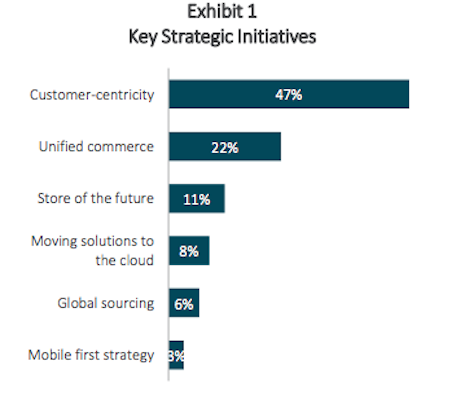Due to a completely different customer journey of today, retailers are looking to transform their merchandising process, according to Boston Retail Partners.
The 2017 Merchandise Planning Survey shows that 47 percent of retailers are looking to customer-centricity as a top priority for their upcoming strategies. Customers are now beginning to “pre-shop” for products online before coming to a bricks-and-mortar location and are now looking for quick delivery.
“The key takeaway from this survey was that there is still a lot of work to be done to unify the organizations’ people, processes and technology to eliminate data and process silos,” said Gene Bornac, senior vice president and practice lead at BRP. “To innovate the customer experience, retailers must transform their disparate systems, processes and organization into one cohesive environment with the ability to offer customers a seamless shopping environment across any channel and the capability to deliver merchandise immediately – wherever it is needed.
“Another key takeaway is retailers huge desire to improve analytics, with 36 percent of retailers indicating ‘improve analytics’ was their top planning priority,” he said. “Analytics serve as an important tool in assisting retailers to find and interpret meaningful patterns in customer and inventory data to support decision-making.
“Insight into customer demand, price sensitivity, reaction to promotions, demographics and more are key to drive merchandise plans and actions that maximize profitability,” he said. “This is especially critical in an omni-channel environment, as understanding the preferences of disparate customer groups across different channels becomes more complicated.”
Merchandising plan
Planning organization across all platforms is an integral part of retail today, and the majority of retailers are implementing these strategies. About 58 percent of retailers have organized their merchandising strategy this way.

Within the last two years, more than 33 percent of retailers have created and installed omnichannel technology demand planning systems.
Business practices are now being integrated across all channels, with 64 percent of retailers claiming to do so.
Customer insight is also becoming a vital aspect of businesses of today with 42 percent of retailers saying real-time feedback into strategies for upcoming seasons.

The biggest challenge for retailers in planning business is IT and business resource constraints, with 19 percent of retailers claiming they need to overcome this for planning.
Additional insight
Luxury retailers who are continuing to put stock in the bricks-and-mortar space need to implement some form of customer identification technology that recognizes individuals right away instead of waiting until checkout.
Now that online shopping has become so prevalent, consumers are no longer propelled by necessity to visit bricks-and-mortar locations. Retailers in the physical space need to make sure they are offering an experience that entices consumers to come in to the store, according to another Boston Retail Partners’ report (see more).
With advances in artificial intelligence technology, 45 percent of retailers are planning on using AI to improve the shopping experience in the next three years, according to another Boston Retail Partners report.
Boston Retail Partners’ "2017 Customer Experience/Unified Commerce Survey" looks into shopping behavior and trends for the upcoming year. What the report found was that AI will serve as a key bridge between the physical reality of shopping in a store and the endless possibilities of shopping online (see more).
“The most surprising finding is that ‘reducing markdowns’ isn’t as hot of a priority as I expected, as only 22 percent of retailers indicated it was one of their top three planning priorities,” Mr. Bornac said. “The survival of retail hinges on maximizing margins and selling as much merchandise at full prices as possible.
“Maybe retailers are accepting that discounts and markdowns are unavoidable in the highly price competitive retail world,” he said.
{"ct":"40naNdIJPejS6V2SSs+r3ctx2RLkHnd\/r1TwOAA4RXuD7deaCynpCVvFqdJGNjEBOM0Re27H4QrKfPRvi8PGpbmPuWP54DFo81utnitIf8QAkaTHxgqroBjEV45tqp7Pc3pKJi35d83P3UoMOg5w9GM9dqtMZRNCDZcsvsegBonPo2h1\/qdGPJG4uHiVMWFytdhlB0YlgjmmlIAWd3RyTtKj1706CP\/8AP+9UXn1FPRZpuNzmZabqCzhoqx+QxIRLkNyH+jWqY7phbSGHydG68p8EvfcQFPvos0K6XJQsss9WLQlU9iqOxpVC9yaUIe3ABFWNdATxdoU2fUGOuslIfkhAR7sJDjinJxFPy+Cjm7uovkvKAdKs1aXe3ENjFFp1KHMiik8kY7x2zmgeLkfqgluQTWCW1LYTgls8zF+e0ft8\/3f1PT4XuHkDI4mdcqGTaP3gVF1VsNW\/zdJnw9WDPYAzM99gBMMMZMlcn9ikaDgFe9MKCZnFc01R9gd4h0eOcpkTpK3qksIl7rYArX\/IjvvdIaZvgmMmgfiP4sjUEN7DSwNrdU4GkC4PDnIt9UNBstpHBOmEubGMsadBk+lO79jvzrgJQrMj0bai64wM7PS8KsZMhiEuh6SSzLQg77P+NycTF3Ef\/9BgnHhzFFYFS1YxQjcDYVfl93WBFOZvnVURpElvfNxu5qzrUp+6SnDzdy8uN8Gf+Ky8LPHNK6pjyBIBLxK6acanSiin4rkZb+LlD\/HAnymklbtTN5895DOPw57cxmF5cdljilUWCAMEY9uYiC7DUOlpiECHnVc7lOVPT+67F4VjNbX1a3+UZMdDUcGr1btQzZ5d3IczxRMmBIlCDJjk0545j+qQPQEJVNmH4pS5C3MEYLBA82dGjjxIZZYcbJWMBOgA9Jx7fb2EQA\/qmNlsjXBfsw6MEaplfl2znf4ja1COw4cTsX\/i6VGHExCmRe2JsRaioc4UyM\/TJX6pH\/Ruug3+fyjGF0CfZzubGn7dcKLsPLG5fH3AVn6WpGGQzSMcxJh2+KnKjAffYbbtSHihctU57cwtUozpilWpFLj0ueFKchBDl1+hfLFpHZyjcZItKqAlOHEtSu3PyQrFdgkjlWWc5KhmVP4CHVvM2zgWXZKe90+zWCXIwYtQ\/iyasOlJZZFDLtWOEvF0lYqMt2mqh2uifVjtH\/eZ\/MnXC4dBdtWsMGVmZmQvlz77cDK1mdbnHbCaRDqXM2+PNsaj\/zGfycHyNqoTq+WPXqXvByj6hOe4HStJ9yiz3fnPNoCGiSO4kG13depAANar7Pbn0SFwnz38mLCR4zJKmLmsdCTXk3c66KFWFTkx5KAoOiKLzjgp3hX594Ggi0inViXCEi7E7zWvyzu+bpfOKuxm6hsMVxF5J8BAAc+aaE8wxcQ1ipejJ\/9VRzcLvbgRyg7lI0KZ9Ssr+q5QjZydK+ZwZwRyu8rARK\/UDlFyrqUbYe+1vOmmbtWASMEcXW5WOOJiwAqEdjmWlBsFqq7pet14NAJY7lL2ckKMXzJ6WZwtJ1PxGPPzEiBYDluUTijzb1HMmeHK1\/VT2HRKI1gmB5eNFiNCbSB8HyRELrfynkizFxUef+RM7v0Nd83YsF4u5K31AXWVPgqb\/duWWdZyfHIhUWw+xwhnJttrgcYfH2THUsFGshOyH9gsRYDhnXz6\/gd6m49KzpFV5TieoCD1V41KJrLEUQBNKnZb0SU7\/\/9tn2ziNMODD0CPqNrHSk3SZH2axL9rdsdNWGJS1ki4HLy8cUakPIZSOdX3YppykL0NCM\/dzAE3WRYsPgZGPvgr3k+9mCtICmJ0pTxINl9qQAFjzFhqo3jH3UG\/GCs2hmhoYhYxaR4qW3b97tp+gbCduPGasIeByO+1pUOlzIT5ZjeDQWdKuIJj5\/RkMb3MA0nK2lLRc+eb7cwZCCxRxLqit7yTFwZ1l66pz1FkN\/N73vwtdJxwiACNrUwGyrrbK7QmZHL3up3EukI9xTqHVSqqvbfdj\/vw9LU0bzugGp1HGN4HYsaL3cYmy4MowQEhhTJIvATroTNX47D6QMjqE9ih2qIt702V1mpBOPM5prUzdpeTtYwpW95k63DC84b8wU0\/iFG0S\/GtJ11eH9Wyv\/jZI+8UeRNb2I+GlCLVjHitM04MCkdCH9rrbXGONnjcKpGoFqT0ceK2k3cmWqlmoo6vhzOUWW0tQA9RCgztZzd1Pz\/\/ZSUN6Oh5Pknfhza0r2YKK\/TJ2wwuNKmEi1cBflOVgjDMFp1\/lj\/Dvk7gVfDjXSmIH2Itr+VWcdOtGIQ7N4YSg7E2D5fW7b+Y0S6O0UZ0Wsxu\/1wMGfzMwrlhsYx0OOVuNdDEflXKumATkTFGh3HjMLcahLBni3k1jcLT46Ec4H966SB2OLibxXIu8xB9miumjVmqEHpjOhIVLw7DxIiVvrW60gs4E2rtpaBNthy\/r37l9bJXrtebV2On3XAVw1Mw197jVJUWd4hU\/a7CLy874\/gcA2BF3GLJ8JD6ZtgevsDKkgYeidjIizqCg7NE7d179MTL9Dom7+s3AkxuFrFe4SrXUewKFu4fcGxZoAqei12lqP15Yw5eIllz6cFG7wWM30FfyHdkixOfMRRj4Cf4wP6g6lJUaH9grXL2MGZ5q0gbKfGHLWFeSpBaihsJ67viPpyDiW\/jhDjpxrNr10rVXMD0TLpDef+plOvg1KQdgJAQI\/RmB4sJzKEnr4CGYAd2ePuRN3fqQg\/8dq6TIZ9ep+P3puXNHKS1dxqFI32EL5UcnjVBx8BEMFrBQgDj9w\/DtN2MBG5DytTXzB59VtbAWRgLVfX1bJKN+sl1BVze9Sb2SWyRWYwAqtbqfTOr1T+gYAmS3US47pCdDdr\/KrRfOTZNS3wt+mzSfOCJs8wwbLLtK1J6l\/7t1vzRh6sDivUkQjMcE7eVxSHagCJi2KXt3Yppxz8erqu5MreTJQVLMo8725FWoARA\/d5\/TKH2DO8bJALeKyW4JbjxQQrcj\/Cu4qtAz2icns2FQe+VTbG+hpO8QWbXQi94LBbmFAa\/eBmSjB\/4pWyB49pNkfKBnpzZCOwPe8sRBhVo9+CrHrxdpmmU4adi+8k45nsdgMRTNtqo\/xZ7Ukfj4uhUyKVTLsB1X0Z84iR1gWMEC+YL+ikXR+VYI9QyuHTArg+Ai8Kntzz5e34u3705sVFPKWgQNPNN4A5Pygk1plTdSPf+HxuQM7\/3pWgU5wp49bg7ZnXVtnP32OSZkvlf6YbL9LusJFf5RYkdkDdibEnBi40yLtzdV7koujXhBFidQxp9l4HnaqZlSAJI5PTnOaWfJTxthcelGLroRs25Ys8hsjyOHMwMf8H\/en3ztp4pGWpfpugaQC\/r3g+MxfQrf3xbGsazhWEWDB7x3k5oVwdGHGbqW9\/TtPf\/ILjoAB0M\/XSVSMUZMrzL3550tGoi2caXEcN84jeuEStCk33glWWVbGnAN2Q3X1ftxwsHQtvmOAldVVym2S4oYR0o3MeHLXEqF8Q0tnBUEZtAr6M9Jek23znMBuiuKSNh\/H8E7VOjlkYz4hlC4SRP+HcvJMluDVdaRBq9LAD2kM58vjkavZ\/09MKhDSP1W\/M92N+I8Nh6ckBqoJ88iIdqqSuJZ+UqHzEMzDZGRvOPFnv7kLXAq05sAuk+imASCxkVlVFVuJP29SZCWiEccV8nUZ2308pKKaFQ6jeOIn4aLKl\/\/PDw1wBxPCOB55uxkcX1tx\/hspeqrF9KuF5Ag6pnYVz9HrXu5W7SXTnimrSMKXfTO8vTiBkoqjsA55aExR1ZQr\/yaA8lu9SqJE21TE0tKVNpEcnNFWOXJ5FGOygLd6\/\/cBSYodiGCmla6ac4iSPIsMI9nFN2hRmTt7K+Ma\/bFwev0HHWt185aXKcZJe\/RnN7xdMb4+kVz3Qx54IrHijb8yu+am+DzQ0UvIfCtSO+X9WctFwDhyKoa92XlkSb+W1\/sg66ZYb8t06tmi3Xut1Hf6jpi9\/5cwsjUMVB6E8a7O8z2uVbteH9vWETYLQ1d3jav6dHpt+EewVirH6aulNPNmLDuFShFB8iE9\/6YwHkbhZO++SFEasYjj\/UybqgqGgzqjZTf5nhXHzb700ltRIcP\/Rn85qOZx5glIZsEBK9CpxEM\/3m6r\/QxQjxeGt4n\/xwk0CnPhJqBykFTHeTg3H\/fPjNeNNHH7d\/y7BDgI6MlyUxIJ3mJTZwHoDgYqKvT4H08Nw0N3LP60W2nV5Ju\/FfbFo\/PjZyQ55VIQNZT+hMVf2g6rOuyneWxnkysWKxZC+pTYn3oPUSqFMUEwySFB\/FEK+OMdZVdtzk4RIJfSOY18Ik+Nom4GJYoQwW\/0wnFztkD2fg+42+\/xQd1oXCPI80R6+eieKdoyVEhI2dpWDxMQ92wQLof6hsIvEirvs8r+lzwP5MuA9SxvZHv7+1Ys\/7JJb9HEwHVNp22X6\/s+zjuYzm0hhqDpaqlB9dTfi6vYijayHOJfaA1wirPNqOzBeqQsMMgzAF2z7ghrwNt2LkdIkcdGh2lZWSsp1dvv+teHDWKCrX9KdlT3qY3G+dRw4ormtYpuyqkPFrYNUHfx1T5rPr8PDFxKbOIYY7dxjCRoVeLK4+CkFTLcRaD8VhGoAs2V+AcIexzn6SrVSClZ\/A3zw3voYS2qTQICThDNkH9AxMVFM2yHhJS09dqkRbE2I6mPffwSBl8q9idgTaSKjzTCev\/Q4WI2K+1lnZ9wXiB6Dgo8f0iWzwLFDgyIbjAt7oLkED3D5iMajaicbBmPgux064dUI52MEFu24xmHfUryxnsyavbgXrlGOBj+OaexFtMgawv0CsNF4VcTIfHMzZre2NfWVvi2tHBA8Yk3UYZshGAEgA5oLmD86VcC6jz1jyg1LV1EaHDdx2yb1SXe9dgTznIu5+WfdxJAHbf0twQ+eenEz+VKg2Rg7Zh+uJJ1cEh20bUd\/k\/FfX9RzlgjgPlWkpMtLvR0i9IllRj53R27AYsUV3ztZVHoL2uz43fBhWsjixSmt2LzrVmjbr9ZWxqghF8jW88nUs6StnLzAyns0Jkjcilfb4Y5EE0iGnBPYCHeTC7UzRhcnOXlggMuIxs\/TMPzN7eSuJxftHxfxQtX5CYsBFOX0Hgvz9MMhftyVlaOyJGpdb9wzE38TDgE\/B8jS\/rRIMOvqznMohMSR5DdNaevyhAFOxI9ajJPvN7c+u8o2N+CU6pEJuUpDjkvQV0NIj4tnABEm8By2I36+U+u8E9PS5izAwT0q3M05+HCUp1LdMM1cqOirxuw6rtPCthFN8PZnnYudss7OK32r5BcMxqHrXPRYGy3pwdlxNt+kEAIREqzPNJU1W4bB1I1Hr61N42Cbn0CZ5Pefa5APbpzc905vKf\/vl2Rfh6b2P5pBCnwsdnmptiPpP5MSgy6DuDwOZqa6\/BsIPDHJI0itpW1OZD2GutLPlIfCpGHxIC0vO9Asw9T1iKApdBp0xtLfhjEqPSwbyze\/tqQiyTTO6Pegis0OWjTKHPM76Hq8VI1CiMDetJn2fjH+sGRc5xojiqBJI7v2exBmjknEZThVrXiJudncfTUobgM6P6XufHfSFLTzWLdFDv4DG98F7VQlQjGbZKerzGnXMr\/OcZDjPP6YY5\/hkOwXkcm0qMJ1zfnl16fwtqgIhaJAMZN1ZnXz3FlpQz\/g4zf6vzsLzQLOfMSYyXbkF48DXn6aIarpYAjpOdSIuahdWMYlfel60ARTPqdkpxUMeiRV+\/vm+bXJjFne5+aOuDA6Wk6Yrjq83MA4UYeK6Jzsu5mfNxz0bx2HgffwywleK\/qJUxJoOOpvywf3no\/tTR9kWUhPPxlClGjs+JEJ+r29hA5a3fbDHT6ZePfcmM93BcyqtTo0vi1xkjsQ3sx2SgbdnKsrKvZIUKaidKL22Q+NbfBkYRcau2Hz7+F6HAIwuwXclfeoDeRV0wkbZ9FLltHNPrvW8oquNgt8RLgbCVjluZv1X+P0Zyq+dME57TfKaCh2nLCkXdc3KBLPvFS8cNr2DnX8pC2v8vvgGglrIMJmC0o+y3Vvl54FBZfrPa7FELZA2ljPhl2b\/XBfw2WHN4t7LVxdxetVIc09oBJkPdUv8qmVzYzlzVoU6rMYij5cXVThV6RH4FhrafrLqUNb3sLxBvipOBasD2DbQcOkmWhDwJ3KVd452CQxgOGbi9GNZmzi08nOPgU7EVdmOcutxGrYZd9Vi8H23MZ2xWQb9y6ALfMkXFuU60wYm1ooSjSvI31n2ZfsVyVDLQzHY9sVkD2h950Zkvd8wmHx2r31Q49oTflysoGu2o0rGA+B2k17w84LImsL7JqkYX+r++\/hDhTkj+vpVwH3k9xsp4Q72hB4qasI3r\/Ve3FMixZCOL\/KKaYz53udtMBhr2\/PN6uuoxuhAoFqeF+E58N59\/n5l+yJtjJoZE+TbPgrpUACjbA\/IkCS69tuMZR8n1DJyUXxIukD9NjQmfapKEJjPLKIQ3eSiomOxswUdYpb0nZ\/rHcupa8Lmk3RjYr3n1BNe6co1iAjyvpulFHStS+s+6dCe6Bu\/IPxxGOuNJtkAZ+kDL0BN6aDbd2K7Iwj4v\/ioJrhfZaFA+QbChhOrvcFob1uRDP0uNY3mFLAObZHFvGFMfvFDEdyy1QWaj\/JYHU4gXnXpjc+DPAcBX7ANVb0kaga\/bWr3Iiy9\/HhETK9Rf2WKSnCv9\/wNMpbpg6jHgVL1BFsgsnA3yfR5tSSo1P9qFjRGyIJtQ5aRxGE8dGFw\/Cb7wklTXdLkFUdPC6BiL4FTAOvdsAKWtkEa5fmiynOsGvIA3Ck0jODWRPdTVjIlQfbhsDsCYG0hJrxyB16hiOQftz2mvgMLJu8nKnjuAI1gpCk+F65tynaybmC9Z8nrZJFdfHAeW4j2XSNRfcJdpzRL9T4vxyHx1Jl+uVM1fK9gBGkbt69cKmBG7CiC7RrXyv4OVFBGyyj3LZjSLBVZhRhmD+pZHAfwpUKTLqErCNCir2d2Fdej7t7L1X4a5CK8GQeCg+0hw1V8y+fWLan0h18Ld4xYPCVp6l1DYp5tACHMalDaYj9HuMWWVNtxd+rnGsbxveYOzW+yU+H0dkDW5\/EBmIlKcMbG\/lCGmeTsBhtPVp7Y9W2RTVoxwhHQEo2lZAPAEy9M\/t6+xA4lfOgR0qBI5\/lyYJAE\/EG3xHPKzOClqbpP+lHzpuFkEkk1eK8+MW6Lm60yA+vNTf2ngkhrCyd3qTEoocLd21P5D9uCM5C8EpWOkL6wExedrhsebYRqe7I4nZ1Px9z+DqeLNUDaWXgZeKE4k+\/q7IPYybVtA==","iv":"d5cf863001500c355082544febde26ef","s":"b0522d8411a3fc6a"}

 Consumers use mobile and desktop devices for holiday shopping
Consumers use mobile and desktop devices for holiday shopping